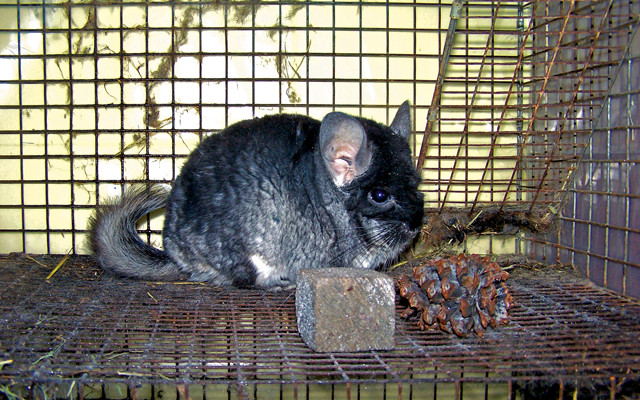
by U.S. Geological Survey Friday, October 23, 2015
Robert D. Crangle, Jr., a mineral commodity specialist at the U.S. Geological Survey’s National Minerals Information Center, compiled the following information on pumice, an essential commodity for the construction, abrasives and horticultural industries.

Pumice is used as a chew toy for chinchillas. Credit: Emily Neef, CC BY-NC 2.0.
Pumice is an extrusive igneous volcanic rock formed through the rapid cooling of air-pocketed lava, which results in a low-density, high-porosity rock. Fine-grained pumice, or pumicite, is defined as minute grains, flakes, threads or shards of volcanic glass, with a size finer than 4 millimeters.
The porous, lightweight properties of pumice are well suited for its main use in the U.S. as an aggregate in lightweight building and decorative blocks. Pumice is also used extensively in abrasive products, including pencil erasers, toothpastes, a variety of heavy-duty hand cleaners, and cosmetic exfoliants for dead skin and hair removal. Stone chew toys for chinchillas, gerbils, guinea pigs, hamsters and rabbits are often made of pumice, which helps the animals file down their sharp teeth. It is also used as a soil amendment and landscaping material in horticulture and as an abrasive for stonewashing denim. Minor applications include its use as an absorbent, a concrete aggregate, a filter aid and a tire traction enhancer.
Elsewhere in the world, pumice is used more extensively as a building material. Because of its light weight, strength and cementitious properties, pumice performs well in European-style construction where less gypsum board is used in favor of prefabricated lightweight concrete walls with pumice as a cement admixture.
All pumice produced in the United States originates from open-pit mines in Arizona, California, Idaho, Kansas, Nevada, New Mexico and Oregon. Processing is typically limited to drying, crushing, screening or expansion. Expansion is accomplished through high-temperature heating, which results in the rupture of embedded air pockets. This causes pumice to rapidly expand, much like popcorn. Expanded pumice is often used in specialized applications and may be sold at a significantly higher price than its crude counterpart.
U.S. and global consumption of pumice in 2015 is expected to remain constant owing to stable demand in the residential and commercial construction sectors.
For more information on pumice and other mineral resources, visit: minerals.usgs.gov/minerals/.
Turkey and Italy lead the world in pumice production, producing 5.7 million metric tons and 3 million metric tons, respectively.
In the U.S. in 2014, 10 companies in six states produced an estimated 285,000 metric tons of pumice.
In 2014, the U.S. exported 14,000 metric tons of pumice to 50 countries and imported 60,000 metric tons from 11 countries.
U.S. apparent consumption of pumice between 2013 and 2014 remained nearly unchanged as a result of stability in residential and commercial construction.
The average unit value of pumice in 2014 in the U.S. was approximately $25 per kilogram.
Some forms of pumice float on water.
Large pumice rafts, often found in areas of submarine volcanic activity, have been known to drift thousands of kilometers, over several years, in oceanic currents.
Recycled glass is used to produce synthetic pumice.
Expanded pumice is used as a filtration medium for beer and vegetable oil.
Pumice is often used as a component in pet litter, diluents, engineered fill, filter aids, geotechnical aids and pottery clays.
© 2008-2021. All rights reserved. Any copying, redistribution or retransmission of any of the contents of this service without the expressed written permission of the American Geosciences Institute is expressly prohibited. Click here for all copyright requests.